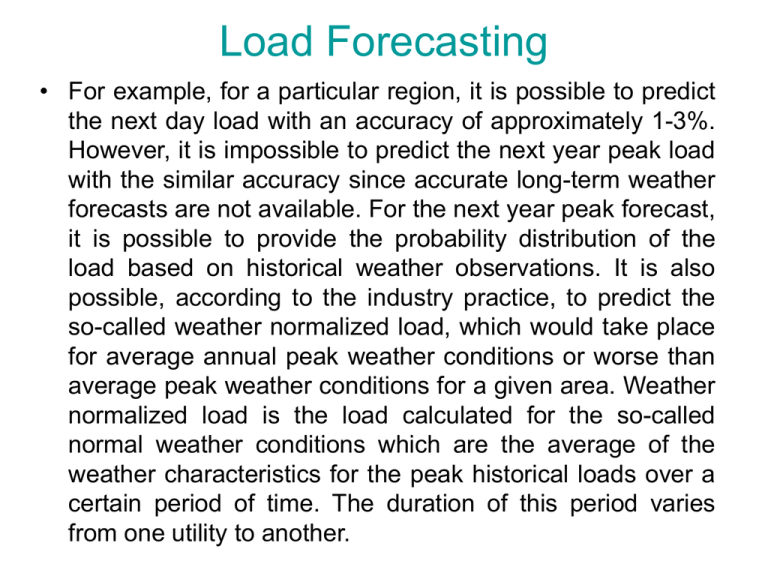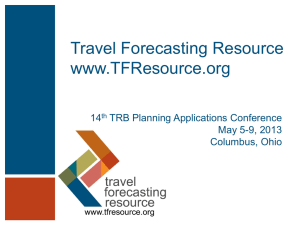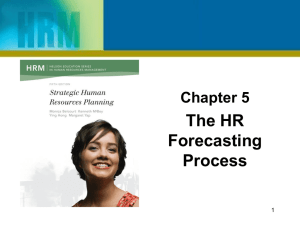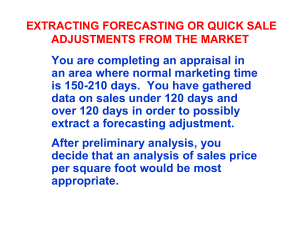Load Forecasting
advertisement

Load Forecasting • For example, for a particular region, it is possible to predict the next day load with an accuracy of approximately 1-3%. However, it is impossible to predict the next year peak load with the similar accuracy since accurate long-term weather forecasts are not available. For the next year peak forecast, it is possible to provide the probability distribution of the load based on historical weather observations. It is also possible, according to the industry practice, to predict the so-called weather normalized load, which would take place for average annual peak weather conditions or worse than average peak weather conditions for a given area. Weather normalized load is the load calculated for the so-called normal weather conditions which are the average of the weather characteristics for the peak historical loads over a certain period of time. The duration of this period varies from one utility to another. Load Forecasting • With supply and demand .fluctuating and the changes of weather conditions and energy prices increasing by a factor often or more during peak situations, load forecasting is vitally important for utilities. • Short-term load forecasting can help to estimate load flows and to make decisions that can prevent overloading. Timely implementations of such decisions lead to the improvement of network reliability and to the reduced occurrences of equipment failures and blackouts. • Load forecasting is also important for contract evaluations and evaluations of various sophisticated financial products on energy pricing offered by the market. • In the deregulated economy, decisions on capital expenditures based on long-term forecasting are also more important than in a non-deregulated economy when rate increases could be justified by capital expenditure on projects. Factors for Load Forecasting Most forecasting methods use statistical techniques or artificial intelligence algorithms such as regression, neural networks, fuzzy logic, and expert systems. Medium & Long-term forecasting Historical load Weather data, the number of customers in different categories the appliances in the area and their characteristics including age, the economic and demographic data and their forecasts, the appliance sales data, and other factors. Short-term forecasting. time factors, weather data, possible customers’ classes. Factors for Load Forecasting The time factors include the time of the year, the day of the week, and the hour of the day. There are important differences in load between weekdays and weekends. The load on different weekdays also can behave differently. For example, Mondays and Fridays being adjacent to weekends, may have structurally different loads than Tuesday through Thursday. This is particularly true during the summer time. Holidays are more difficult to forecast than non-holidays because of their relative infrequent occurrence. Factors for Load Forecasting Weather conditions influence the load. In fact, forecasted weather parameters are the most important factors for load forecasting. Most commonly used load predictors Temperature and humidity Among the weather variables listed above, two composite weather variable functions, the THI (temperature-humidity index) and the WCI (wind chill index), are broadly used by utility companies. THI is a measure of summer heat discomfort WCI is cold stress in winter. Most electric utilities serve customers of different types such as residential, commercial, and industrial. The electric usage pattern is different for customers that belong to different classes but is somewhat alike for customers within each class. Therefore, most utilities distinguish load behavior on a class-by-class basis Methods of Load Forecasting Most forecasting methods use statistical techniques or artificial intelligence algorithms such as regression, neural networks, fuzzy logic, and expert systems. for medium- and long-term forecasting End-use and econometric approach are broadly used for short-term forecasting. Similar day approach, Various Regression models, Time series, Neural networks, Statistical learning algorithms, Fuzzy logic, Expert systems Methods of Load Forecasting Statistical approaches usually require a mathematical model that represents load as function of different factors such as time, weather, and customer class. The two important categories of such mathematical models are: additive models multiplicative models. They differ in whether the forecast load is the sum (additive) of a number of components the product (multiplicative) of a number of factors. Methods of Load Forecasting An additive model that takes the form of predicting load as the function of four components: = Ln + Lw + Ls + Lr, where L is the total load, Ln represents the “normal” part of the load, which is a set of standardized load shapes for each “type” of day that has been identified as occurring throughout the year, Lw represents the weather sensitive part of the load, Ls is a special event component that create a substantial deviation from the usual load pattern, Lr is a completely random term, the noise. It is also suggested electricity pricing as an additional term that can be included in the model. Naturally, price increases /decreases affect electricity consumption. Large cost sensitive industrial and institutional loads can have a significant effect on loads. Methods of Load Forecasting A multiplicative model may be of the form L = Ln · Fw · Fs · Fr, Ln is the normal (base) load and the correction factors Fw, Fs, and Fr are positive numbers that can increase or decrease the overall load. These corrections are based on current weather (Fw), special events (Fs),and random fluctuation (Fr). Factors such as electricity pricing (Fp) and load growth (Fg) can also be included. Methods of Load Forecasting Medium & Long Term Load Forecasting The end-use modeling, econometric modeling, and their combinations are the most often used methods for mediumand long-term load forecasting. Descriptions of appliances used by customers, the sizes of the houses, the age of equipment, technology changes, customer behavior, population dynamics are usually included in the statistical and simulation models based on the so-called end-use approach. In addition, economic factors such as per capita incomes, employment levels, and electricity prices are included in econometric models. These models are often used in combination with the end-use approach. Long-term forecasts include the forecasts on the population changes, economic development, industrial construction, and technology development. Methods of Load Forecasting Medium & Long Term Load Forecasting End-use models The end-use approach directly estimates energy consumption by using extensive information on end use and end users, such as appliances, the customer use, their age, sizes of houses, and so on. Statistical information about customers along with dynamics of change is the basis for the forecast. End-use models focus on the various uses of electricity in the residential, commercial, and industrial sector. These models are based on the principle that electricity demand is derived from customer’s demand for light, cooling, heating, refrigeration, etc. Thus end-use models explain energy demand as a function of the number of appliances in the market sensitive to the amount and quality of end-use data. For example, in this method the distribution of equipment age is important for particular types of appliances. End-use forecast requires less historical data but more information about customers and their equipment. Methods of Load Forecasting Medium & Long Term Load Forecasting Econometric models. The econometric approach combines economic theory and statistical techniques for forecasting electricity demand. The approach estimates the relationships between energy consumption (dependent variables) and factors influencing consumption. The relationships are estimated by the least-squares method or time series methods. One of the options in this framework is to aggregate the econometric approach, when consumption in different sectors (residential, commercial, industrial, etc.) is calculated as a function of weather, economic and other variables, and then estimates are assembled using recent historical data. Integration of the econometric approach into the end-use approach introduces behavioral components into the enduse equations. Methods of Load Forecasting Statistical model-based learning The end-use and econometric methods require a large amount of information relevant to appliances, customers, economics, etc. Their application is complicated and requires human participation. In addition such information is often not available regarding particular customers and a utility keeps and supports a profile of an “average” customer or average customers for different type of customers. The problem arises if the utility wants to conduct next-year forecasts for subareas, which are often called load pockets. In order to simplify the medium-term forecasts, make them more accurate and avoid the use of the unavailable information. Methods of Load Forecasting The focus of the study was the summer data. We compared several load models and came to the conclusion that the following multiplicative model is the most accurate L(t) = F(d(t), h(t)) · f(w(t)) + R(t), where L(t) is the actual load at time t, d(t) is the day of the week, h(t) is the hour of the day, F(d, h) is the daily and hourly component, w(t) is the weather data that include the temperature and humidity, f(w) is the weather factor, and R(t) is a random error. In fact, w(t) is a vector that consists of the current and lagged weather variables. This reflects the fact that electric load depends not only on the current weather conditions but also on the weather during the previous hours and days. In particular, the well-known effect of the so-called heat waves is that the use of air conditioners increases when the hot Methods of Load Forecasting Short Term Load Forecasting Methods of Short Term Load forecasting Similar-day approach Regression methods Time series Neural networks Expert systems Fuzzy logic. Methods of Load Forecasting Short Term Load Forecasting Similar-day approach This approach is based on searching historical data for days within one, two, or three years with similar characteristics to the forecast day. Similar characteristics include weather, day of the week, and the date. The load of a similar day is considered as a forecast. Instead of a single similar day load, the forecast can be a linear combination or regression procedure that can include several similar days. The trend coefficients can be used for similar days in the previous years. Methods of Load Forecasting Short Term Load Forecasting Regression methods used to model the relationship of load consumption and other factors such as weather, day type, and customer class. several regression models for the next day peak forecasting. Their models incorporate deterministic influences such as holidays, stochastic influences such as average loads, and exogenous influences such as weather. Methods of Load Forecasting Short Term Load Forecasting Time series Time series methods are based on the assumption that the data have an internal structure, such as autocorrelation, trend, or seasonal variation. Time series forecasting methods detect and explore such a structure. Time series have been used for decades in such fields as economics, digital signal processing, as well as electric load forecasting. Methods of Load Forecasting Short Term Load Forecasting Time series ARMA (autoregressive moving average), ARIMA (autoregressive integrated moving average), ARMAX (autoregressive moving average with exogenous variables), ARIMAX (autoregressive integrated moving average with exogenous variables) are the most often used classical time series methods. ARMA models are usually used for stationary processes while ARIMA is an extension of ARMA to nonstationary processes. ARMA and ARIMA use the time and load as the only input parameters. Since load generally depends on the weather and time of the day, ARIMAX is the most natural tool for load forecasting among Methods of Load Forecasting Short Term Load Forecasting Neural networks The use of artificial neural networks (ANN) has been a widely studied electric load forecasting technique since 1990. Neural networks are essentially non-linear circuits that have the demonstrated capability to do non-linear curve fitting. The outputs of an artificial neural network are some linear or nonlinear mathematical function of its inputs. The inputs may be the outputs of other network elements as well as actual network inputs. In practice network elements are arranged in a relatively small number of connected layers of elements between network inputs and outputs. Feedback paths are sometimes used. Methods of Load Forecasting Short Term Load Forecasting Neural networks In applying a neural network to electric load forecasting, one must select one of a number of architectures (e.g. Hopfield, back propagation, Boltzmann machine), the number and connectivity of layers and elements, use of bi-directional or uni-directional links, and the number format (e.g. binary or continuous) to be used by inputs and outputs,and internally. The most popular artificial neural network architecture for electric load forecasting is back propagation. Back propagation neural networks use continuously valued functions and supervised learning. Methods of Load Forecasting Short Term Load Forecasting Expert systems Rule based forecasting makes use of rules, which are often heuristic in nature, to do accurate forecasting. Expert systems incorporates rules and procedures used by human experts in the field of interest into software that is then able to automatically make forecasts without human assistance. This rule base is complemented by a parameter database that varies from site to site. Methods of Load Forecasting Short Term Load Forecasting Fuzzy logic Fuzzy logic is a generalization of the usual Boolean logic used for digital circuit design. An input under Boolean logic takes on a truth value of “0” or “1”. Under fuzzy logic an input has associated with it a certain qualitative ranges. For instance a transformer load may be “low”, “medium” and “high”. Fuzzy logic allows one to (logically) deduce outputs from fuzzy inputs. In this sense fuzzy logic is one of a number of techniques for mapping inputs to outputs (i.e. curve fitting). Among the advantages of fuzzy logic are the absence of a need for a mathematical model mapping inputs to outputs and the absence of a need for precise (or even noise free) inputs. Methods of Load Forecasting The development and improvements of appropriate mathematical tools will lead to the development of more accurate load forecasting techniques. The accuracy of load forecasting depends not only on the load forecasting techniques, but also on the accuracy of forecasted weather scenarios.








